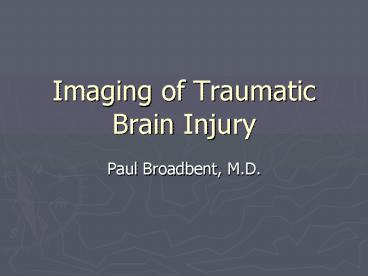Imaging of Traumatic Brain Injury - PowerPoint PPT Presentation
1 / 53
Title:
Imaging of Traumatic Brain Injury
Description:
Traumatic brain injury has multiple mechanisms and varied ... Occur in characteristic locations where brain is adjacent to bony protuberance or dural fold ... – PowerPoint PPT presentation
Number of Views:125
Avg rating:3.0/5.0
Title: Imaging of Traumatic Brain Injury
1
Imaging of Traumatic Brain Injury
- Paul Broadbent, M.D.
2
(No Transcript)
3
Overview
- Traumatic brain injury has multiple mechanisms
and varied presentations - Imaging plays an important role in evaluating the
full spectrum of these patients - New imaging techniques provide additional insight
into the diagnosis and treatment of these
patients
4
Mild Traumatic Brain Injury
- 1.2 million Americans are evaluated in EDs
annually for concussion or mild TBI - ¼ of all patients with TBI have symptoms that
persist beyond 1 year (320,000 per year)
5
TBI Defined
- Traumatic brain injury occurs when a sudden
trauma causes damage to the brain - Person may or may not experience a loss of
consciousness at the time of injury. - Symptoms of mild TBI include headache,
confusion, lightheadedness, dizziness, blurred
vision, ringing in the ears, fatigue, change in
sleep patterns, mood changes
6
TBI Symptoms Continued
- Behavioral changes, trouble with memory,
concentration, attention or thinking. - Patients with moderate or severe TBI may
experience the above symptoms as well as nausea,
seizures, weakness, numbness, confusion,
restlessness or agitation. - source NINDS
7
(No Transcript)
8
Imaging Tools Old School to Cutting Edge
- Plain Radiographs
- Computed Tomography (CT)
- MRI with standard anatomic sequences
- Gradient Echo (Blood sensitive) MRI
- Diffusion Tensor Imaging
- Spectroscopy
- fMRI
- Perfusion Imaging
- Quantitative techniques
9
Skull Radiographs
10
Skull Radiographs
- Limited information such as depressed or
displaced fractures and sinus opacity - Does not predict presence or degree of brain
injury - Generally not a part of the modern evaluation of
head injury
11
Computed Tomography
12
Head CT
- Advantages for TBI include availability, short
scan times, detailed anatomic information -
including evaluation of facial and temporal bone
fractures - Less sensitive for small parenchyma bleeds such
as those seen with DAI
13
Anatomic Patterns of Traumatic Brain injury
- Blood epidural, subdural, parenchyma,
ventricular, and subarachnoid - Direct injury to brain frontal lobe and
anterior temporal lobe - Sheering injury deformation of brain causing
diffuse axonal injury
14
45 y.o. with remote TBI
15
GE 3T MRI Scanner
16
45 y.o. with headaches and remote head injury
17
Traumatic Contusion Location
- Occur in characteristic locations where brain is
adjacent to bony protuberance or dural fold - Nearly 50 involve temporal lobes
- 33 involve frontal lobe surfaces such as gyrus
rectus as noted in index case - 25 parasagital
- Multiple bilateral lesions in 90
- source Osborn et al Diagnsotic Imaging - Brain
18
TBI DAI, Contusion and subdural Hemorrhage
Taber et al. J Neuropsychiatry Clin Neurosci
18141-145, May 2006
19
Combat Related Blast Injury
20
59 y.o. female with TBI X2 Recent and Remote
21
T2 and Gradient Echo
22
MR Spectroscopy
23
Multivoxel Spectroscopy
24
42 y.o. male passenger in MVC
Scheid et al AJNR June/July 2003
25
39 y.o. female who fell from a horseGCS14
Scheid et al AJNR June/July 2003
26
27 y.o. Male Remote TBI
27
3T MRIAll Roads Lead To Disconnection
28
MR Imaging Detection of Cerebral Microbleeds
Effect of SWI, Thickness and Field Strength
Namdigram et al
29
SWI at 3T
30
Words the cool kids use
- Notion noh-shuhn noun. An opinion, view,
or belief. Conception or idea. - Wonk wongk noun. A person who studies a
subject or issue in an excessively assiduous and
thorough manner a policy wonk. - Anisotropy Not isotropic. Having properties
that differ according to direction of
measurement.
31
Cool Words Defined
- Fractional anisotropy Directionality of water
molecules with values between 0 (perfectly
isotropic diffusion) and 1 (the hypothetical case
of an infinite cylinder)
32
Cool words continued
- Brownian motion the random movement of
microscopic particles caused by collisions with
molecules of medium.
33
Diffusion
Jellison et al AJNR 25356-359, March 2004
34
40 y.o. male 7 days after TBI demonstrates DAI
Traumatic Brain Injury Diffusion-Weighted MR
Imaging findings AJNR 201636 1641 Liu et al
35
9 patients with DAI
36
Color coded FA with ROI from control study
participant
Yuan et al AJNR Nov-Dec 2007
37
Diffusion Tensor Color Map
38
Fiber Tracking at 3T
39
Fiber Tracts at 3T
40
15 y.o. female ejected from car with normal GOS
at 12 months
Holshouser et al AJNR May 2005
41
Frequency Distribution of Blood Flow
Abnormalities in Focal Patients
42
Frequency Distribution of Blood Flow
Abnormalities in Diffuse Patients
SPECT Imaging in Head Injury Interpreted with
Statistical Parametric Mapping Stamatakis et al
Journal of Nuc Med Vol 43 2002
43
33 y.o. male after Sports InjuryGCS 15 on
Admission
44
Tennis Anyone?
- In there study Detecting Awareness in the
Vegetative State Owens et al. used fMRI to
demonstrate preserved conscious awareness in a
vegetative state. - When asked to imagine playing tennis the patient
activated cortical areas in a manner
indistinguishable from normal volunteers
45
(No Transcript)
46
(No Transcript)
47
Conclusion
- TBI is a broad spectrum entity with varied
mechanisms and presentations - Imaging plays an important role in the diagnosis
and treatment of these patients from the mild to
severely injured - Imaging techniques are evolving rapidly and
moving far beyond the evaluation for gross blood
or skull fracture - Evaluation is greatly effected by knowing what to
look for and having these powerful imaging tools
available
48
Thank You For Your AttentionDrive Safely!
49
(No Transcript)
50
(No Transcript)
51
Gradient Echo Imaging
52
AVM with prior Hemorhage
53
(No Transcript)

